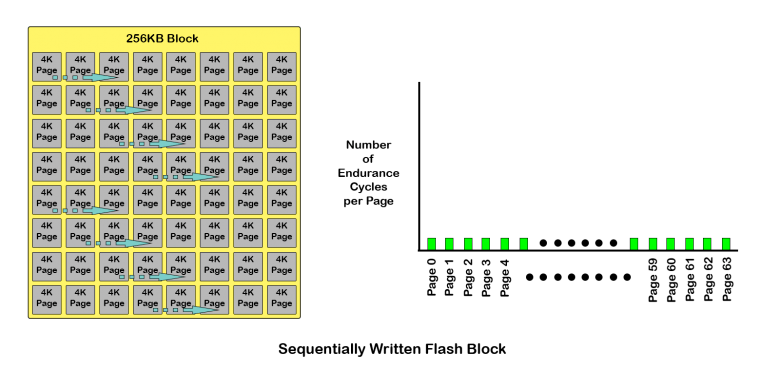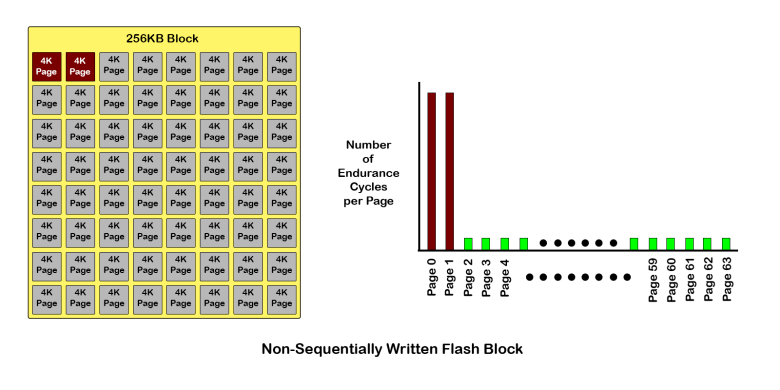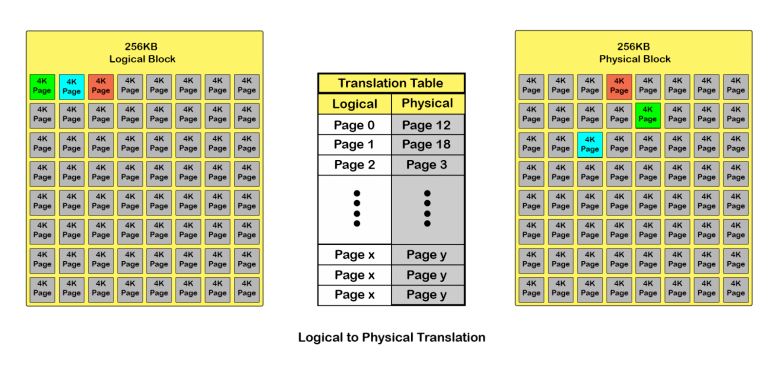Solid State Drive Primer # 10 - Controller Functions - Wear Leveling
A SSD controller receives commands from the host system which tell it where to read or write a piece of data. For simplicity of this article on Wear Leveling we will make two assumptions: 1) Each piece of data is 4KB and; 2) The NAND pages are also 4KB. In real world situations, the sizes of the data and page sizes can vary depending on host system and NAND memory used.
The host system provides the Logical Block Address (LBA) of the data it would like to read or write. It would be relatively straight forward for the SSD controller to simply read or write the LBA to the exact same Physical Block Address. Let’s take a look at what would occur.
Wear Leveling and Sequential Writing to NAND Memory:

The image above shows a 256KB NAND block which is comprised of 64 Pages containing 4KB of storage capacity each. If the host system writes 256KB of data in sequential LBAs and the SSD controller stores this data in sequential Physical Block Addresses - starting at the first 4K Page and ending at the 64th in the block - then there has effectively been 1 endurance cycle used for the entire block.
The chart to the right of the 256KB block shows how sequential data is the ideal method of storing data in a NAND flash device. It evenly distributes all of the write cycles to the NAND Pages and Blocks so that one individual NAND Page/Block is not worn out prior to other Pages/Blocks.
Before continuing a couple clarifications:
- An Endurance cycle only occurs when an erase occurs, so on the first write, there is actually not an endurance cycle.
- Reading a NAND cell does not affect the endurance cycles of the NAND cell
Wear Leveling and Non-Sequential Writing to NAND Memory:

Unfortunately, real life usage of the SSDs rarely have the ideal sequential usage patterns. There are File system directories which need to be updated after any file is altered. There are mismatches in the data sizes from the host and the Page/Block sizes of the NAND on the SSD. There is the need to reclaim previously written blocks and many other factors.
The Non-Sequential image above shows a worst case situation where data is constantly written to only the first two 4K Pages. If the SSD controller just continued writing this data to these physical pages of the NAND, it would quickly exhaust the total number of endurance cycles of these cells.
What Wear Leveling Does?
Wear Leveling algorithms in SSD controllers attempt to evenly distribute host system writes throughout the entire SSD. Since NAND flash has a finite number of writes per block, wear leveling attempts to use every endurance cycle of the SSD prior to the end of its useful life.
There are many different schemes used by the different SSD controller designers, but they all share a couple characteristics.

As shown above, they store the host data written for a Logical Block Address (LBA) to a physical location that has the least amount of endurance cycles used. Host data written to the same LBA is typically not stored in the same physical location of NAND. The controller must keep track of the translation from Logical to Physical block in a table or other method.
Another common occurrence is when static data on the SSD never moves - such as Operating System and Application data. It’s stored once on the SSD and thereafter left alone. For these situations most new controllers will automatically move this static data to other physical NAND locations so they can take advantage of the endurance cycles of these NAND cells.
All alone, Wear Leveling cannot solve all an SSD’s tasks, but it is an important part to creating a more reliable SSD which efficiently uses the limited endurance available in NAND memory.
The next article will continue with additional issues and methods SSDs use to address them.
If you would like to discuss this further please contact us.






